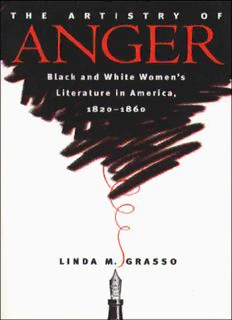
The Artistry of Anger: Black and White Women's Literature in America, 1820-1860 (Gender and American Culture) PDF
Preview The Artistry of Anger: Black and White Women's Literature in America, 1820-1860 (Gender and American Culture)
the artistry of anger G A C ender and merican ulture coeditors Thadious M. Davis Linda K. Kerber editorial advisory board Nancy Cott Cathy N. Davidson Jane Sherron De Hart Sara Evans Mary Kelley Annette Kolodny Wendy Martin Nell Irvin Painter Janice Radway Barbara Sicherman T he A rtistry of Black and White Women’s Literature in America, 1820–1860 Linda M. Grasso The University of North Carolina Press Chapel Hill and London ∫ 2002 The University of North Carolina Press All rights reserved Designed by April Leidig-Higgins Set in Monotype Centaur by Keystone Typesetting, Inc. Manufactured in the United States of America The paper in this book meets the guidelines for permanence and durability of the Committee on Production Guidelines for Book Longevity of the Council on Library Resources. Portions of Chapter 6 appeared previously, in somewhat di√erent form, in ‘‘Anger in the House: Fanny Fern’s Ruth Hall and the Redrawing of Emotional Boundaries in Mid- Nineteenth-Century America,’’ Studies in the American Renaissance (1995): 251–61. Library of Congress Cataloging-in-Publication Data Grasso, Linda M. The artistry of anger : black and white women’s literature in America, 1820–1860 / Linda M. Grasso. p. cm. — (Gender and American culture) Includes bibliographical references and index. isbn 0-8078-2682-0 (cloth : alk. paper) — isbn 0-8078-5348-8 (pbk. : alk. paper) 1. American fiction—Women authors—History and criticism. 2. Feminism and literature—United States—History—19th century. 3. Women and literature—United States—History—19th century. 4. American fiction—African American authors—History and criticism. 5. American fiction—19th century—History and criticism. 6. Feminist fiction, American—History and criticism. 7. African American women in literature. 8. Social problems in literature. 9. White women in literature. 10. Anger in literature. I. Title. II. Gender & American culture. ps374.f45 g73 2002 813%.3099287—dc21 2001040614 Cloth 06 05 04 03 02 5 4 3 2 1 Paper 06 05 04 03 02 5 4 3 2 1 T o my teachers Bonnie Anderson, Mari Jo Buhle, Kenneth Bru√ee, Thadious Davis, David Hirsch, Robert Lee, Doris Meyer, Linda Miller, Katherine A. Monteiro, Steven Murray, Lillian Schlissel, Michael Southwell and to my students at Brown University, Columbus State University, and the City University of New York (Brooklyn College and York College) contents Acknowledgments ix Part One. The Anger Paradigm: Theories and Contexts Chapter One Anger as Analysis and Aesthetic in American Women’s Literature 3 Chapter Two Using the Anger Paradigm: The Antebellum Period as Case Study 19 Chapter Three Suppressing Treasonous Anger: Nation-Building and Gendered Ideologies of Anger in Antebellum America 41 Part Two. Anger in the House and in the Text: Four Case Studies Chapter Four Anger, Exile, and Restitution in Lydia Maria Child’s Hobomok 71 Chapter Five Maria W. Stewart’s Inspired Wrath 101 Chapter Six Masking Anger as It Is Spoken: Fanny Fern’s Ruth Hall 135 Chapter Seven The Text as Courtroom: Judgment, Vengeance, and Punishment in Harriet Wilson’s Our Nig 163 Conclusion: Making Sure the Anger Holds 193 Notes 197 Bibliography 219 Index 239 acknowledgments Over the years, I often wished that what many nineteenth-century women claimed had happened to them would happen to me: that a deity would write the book for me. Although this never occurred, I am grateful to the many individuals, communities, and institutions who extended intellectual energy, emotional sustenance, and financial resources during the many years I worked on this book. The generosity of these gifts was indeed godlike to the struggling scholar who ‘‘scribbled on,’’ hoping that her manuscript would eventually enter the ‘‘port of Independence.’’ At Brown University, where this book assumed its first life as a doc- toral dissertation, I was mentored by three extraordinary scholars: Thadi- ous Davis, Mari Jo Buhle, and David Hirsh. Each guided me through the dissertation-writing process with patience, wisdom, and humor. I am par- ticularly grateful to Thadious Davis for her steadfast belief in the project since its inception; to Mari Jo Buhle for teaching me how to understand nineteenth-century women on their own terms; and to David Hirsh for encouraging me to take intellectual risks. I regret that David is not here to see how I have continued to heed his counsel. Many scholars and friends helped me to refine my ideas about nineteenth- century women writers and anger as this project evolved. Bonnie Anderson, Gail Bederman, Frederick DeNaples, Ann Du Cille, Nora Eisenberg, Ruth Feldstein, Cheryl Fish, Elizabeth Francis, Jane Gerhard, Katie Hogan, Eliza La≈n, Carol Mason, Melani McCalister, Bob McMichael, Kate Monteiro,
Description: